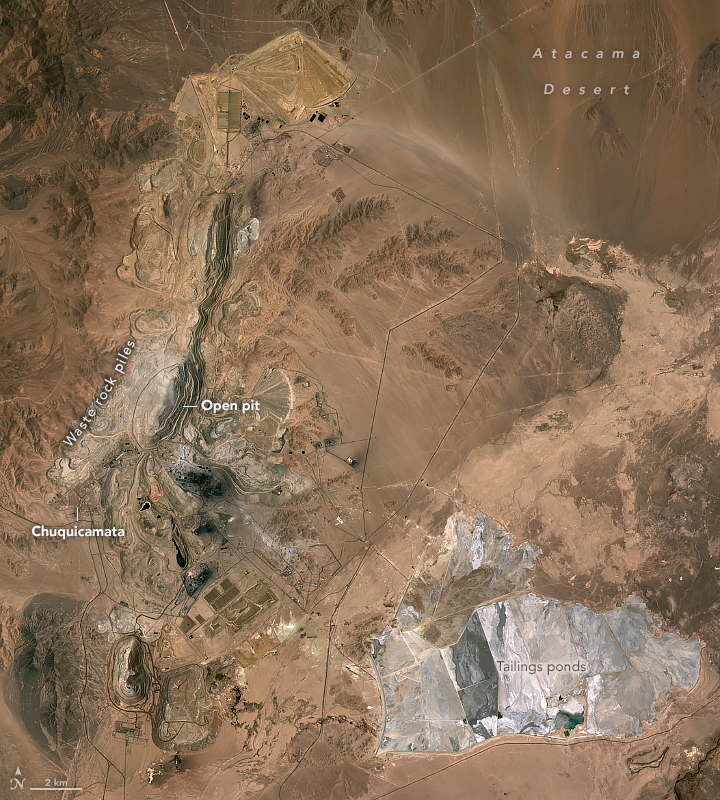
Copper Mining at Chuquicamata
Downloads
- chuquicamata_mine_oli2_20240104_lrg.jpg (1827x2030, JPEG)
Metadata
- Sensor(s):
- Landsat 9 - OLI-2
- Data Date: January 4, 2024
- Visualization Date: January 25, 2024
The Chuquicamata mine in northern Chile’s Atacama Desert is one of the deepest open-pit mines in the world, second only to Bingham Canyon in Utah. The extraction of huge stores of copper has hollowed out the landscape; the largest pit at the site reaches a depth of approximately 1,000 meters (3,300 feet). Evidence of mining here dates as far back as the sixth century C.E., but the modern era of mining began in the 1910s. Within the past several years, operations have moved underground and extraction from open pits has waned.
The scars of mining activity are visible in this image, acquired by the OLI-2 (Operational Land Imager-2) on Landsat 9 on January 4, 2024. Terrace-like mining benches, which support work equipment and catch material from debris slides, appear as concentric rings in the pits. Piles of waste rock containing low concentrations of minable metals lie adjacent to them. Farther afield, tailings ponds hold residual material from the ore enrichment process.
Chuquicamata’s extensive porphyry copper deposits, which form when hot fluids circulate through igneous rocks, have attracted fortune-seekers for centuries. In 1899, a well-preserved mummy was found at the mining site. The man is believed to have been a miner who died in approximately 550 C.E.
Modern mining operations started in 1915, buoyed by new ore-processing technologies and investment from the Guggenheim family’s Chile Exploration Company. Throughout the ensuing decades, the open pits grew wider, deeper, and more numerous, and the footprint of waste rock piles expanded. Dust, gases, and other mining byproducts imperiled the health and safety of residents in the town of Chuquicamata, which was first established as a camp near the mining operations. Starting in 2004, residents began relocating to Calama, a city about 15 kilometers to the south (not shown), leaving the town completely abandoned as of 2007.
In 2019, underground mining began at Chuquicamata as part of a multi-billion-dollar overhaul of operations. The effort aims to reach additional deposits amid slowing productivity and is expected to extend the useful life of the site by at least 40 years, according to the mining company.
Production at the Chuquicamata mine contributes to Chile’s standing as the world’s top copper producing country. Chile’s output accounted for 27 percent of the global supply in 2021.
References
- Codelco Key Financial & Operational Data. Accessed January 24, 2024.
- Foreign Policy (2023, November 18) Living in a Material World. Accessed January 24, 2024.
- Geological Survey of Sweden Chapter 4: Mining Waste. Accessed January 24, 2024.
- Mining.com (2019, May 1) Codelco kicks off underground mining at Chuquicamata. Accessed January 24, 2024.
- NASA Earth Observatory (2007, October 22) Bingham Canyon Mine, Utah. Accessed January 24, 2024.
- NASA Earth Observatory (2013, June 13) Sizing up the Landslide at Bingham Canyon Mine. Accessed January 24, 2024.
- NS Energy Chuquicamata Copper Mine. Accessed January 24, 2024.
- USGS Earth Resources Observation and Science Center (2022) Chuquicamata Mine, Chile. Accessed January 24, 2024.
- USGS Earth Resources Observation and Science Center (2020) Moving a Town. Accessed January 24, 2024.
NASA Earth Observatory image by Michala Garrison, using Landsat data from the U.S. Geological Survey. Story by Lindsey Doermann.
This image record originally appeared on the Earth Observatory. Click here to view the full, original record.